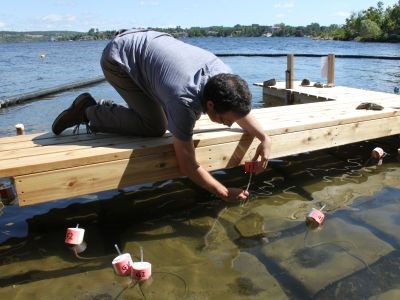More than a century after mining operations began in Sudbury, a British researcher has taken up residence at the Vale Living with Lakes Centre to look at the long-term impacts those activities have had on local fish populations.
Dr. Andrew Tanentzap, a lecturer with the University of Cambridge in England, and his crew of six students are conducting a two-year study that examines the near-shore environments of the lake bottom to determine how they impact fish populations, which in turn is an indicator of the impact mining and forestry activity has had.
The project is being funded by the British government’s Natural Environment Research Council.
Tanentzap said the research centre is the ideal place to conduct the study, for the world-class facilities and expertise it offers.
“The facilities here are unparalleled internationally, in terms of the support for what we’re doing,” Tanentzap said. “If you’re interested in the world’s fresh water, this is where you come to, because this is where the world’s fresh water is.”
Though Tanentzap has worked with Laurentian for more than 10 years, he’s only gone to Cambridge recently. But he’s hopeful this study is just the start to establishing further links between the two universities.
Sudbury’s reforestation efforts have almost been too successful, in that, to the public eye, the work is largely complete. But the fish populations haven’t recovered nearly as well as the forests, Tanentzap said.
Forests are essential to thriving fish populations. Trees shed leaves and small twigs, creating litter fall, which gets washed into nearby streams and are eventually carried into lakes. The larger, heavier material starts accumulating, creating a delta, or near-shore environment.
“They’re really important biologically, because all the material that accumulates there is going to support organisms and others trying to make a living off of breaking down that material, and then it’s going to support other organisms that eat those things that are breaking down the leaf material,” Tanentzap said. “So these near-shore environments are really important hot spots for biological activity.”
Fish like perch, which lay their eggs in those near-shore environments, benefit directly from the foliage that accumulates in those environments. Bacteria breaks down the foliage that has accumulated, plankton feed on the bacteria, and fish feed on the plankton.
“Those tree leaves work their way up the food web, from the microscopic things all the way up to fish,” Tanentzap said.
Last year, initial research conducted in Sudbury’s Daisy Lake showed that the yellow perch located beneath the catchments with more forest cover grew up to four times larger than those that did not. Fish size is important because the larger the fish, the greater chance for survival, Tanentzap said.
So where does mining come in?
Tanentzap said the smelters in Coniston, historically owned by INCO (now Vale), are two kilometres from the tip of Daisy Lake. Catchment areas that are further from the smelters were less damaged by acid and metal particles emitted by the smelters, and they’ve recovered more naturally than areas closer to the smelters.
“If we take a fish, we can measure its chemical signature and relate it to the signature of leaves and the signature of algae to work out where it’s getting its food from,” the researcher added.
Now, the researchers are taking their work to the next step, which is to recreate the near-shore catchment areas to see how different environments impact fish populations. They’ve accumulated forest cover — twigs, leaves, rocks, silt — into boxes to mimic what’s found on the lake bottom, based on different forest types.
“That has really important applications for industry, whether it’s restoration or regreening, and understanding how actions on land have consequences for receiving waters,” Tanentzap said.
For example, what will the impact to fish populations be if they remove 20 per cent or 40 per cent of the forest cover?
“At the end of the day, the ultimate goal is to be able to say, if we take 10 per cent of the trees out of the catchment, the fish populations are going to change by X per cent, and try to understand that link between the forests, what they’re producing, how that’s supporting the food web, and work all the way to something we really care about, which are the fish,” Tanentzap said.
Tanentzap said there has been interest from industry in his work. Included in his initial grant proposal for the research were letters of support from the City of Greater Sudbury, Vale and Xstrata, and all have shown further interest in his research.
Results from his work will be compiled into a report and presented following the two-year study period.




